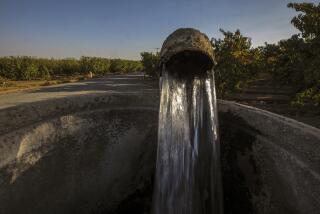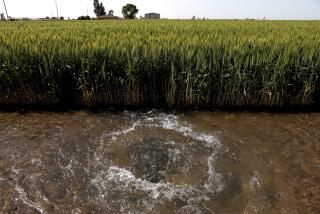Bill Drafted to Widen Authority of Governor to Ease Pain of Drought
- Share via
SACRAMENTO — Predicting a 30% chance of a significant water shortage in the state next year, the Deukmejian Administration is cautiously promoting legislation that would allow it to deal with what could be the third year of a continuing drought, state water officials said Wednesday.
The bill, by Sen. Ruben S. Ayala (D-Chino), would direct the state Department of Water Resources to draw up and implement a drought plan that could include such steps as building pipelines and shipping water to drought-stricken areas, opening up alternative water supplies, temporarily lowering health standards for drinking water and offering financial aid to local water districts.
Similar actions were taken in 1977 at the height of the last (and more severe) drought, without such legislation on the books. As the department’s assistant chief counsel, Katherine Striemer, pointed out, “We have the powers to do what is there (in the bill).”
But the measure is significant because it reflects the Administration’s cautious, consensus approach to water issues, in a state where “water” remains a fighting word and where the diversion of water can lead to political warfare.
“A lot of people fear the department will take these powers onto itself,” said Terrence M. Eagan, undersecretary of the state Resources Agency. “We want to keep Water Resources a department of state government. We don’t want to create a water czardom.”
“Part of it is giving the legislators the ability to go back to their constituents and say, ‘We have dealt with the emergency,’ ” said Thomas J. Graff, senior attorney for the Environmental Defense Fund.
Graff said that Gov. George Deukmejian was “burned” in 1984, when he failed to win legislative support for his plan to ship additional Northern California water south through the State Water Project. As a result of the loss, Graff said, the governor “doesn’t want to do anything that will hurt him. From our point of view, it’s been a lot better than having them crash ahead, building dams.”
Ayala, who chairs the Senate Agriculture and Water Resources Committee, acknowledged in an interview that the governor already has broad powers to divert water to drought-stricken areas in a declared emergency. But believing that there ought to be a statewide drought emergency plan on the books, Ayala met with the governor in June, asking him to “tell us the tools he needs in case of a drought situation.”
Groups Consulted
The governor agreed in principle to back a water bill, which was drafted after consulting with the California Chamber of Commerce, local water agencies and water contractors. Representatives of environmental groups, including Graff, saw the measure for the first time earlier this week.
Deukmejian, who is on a trade mission to Asian countries, has not yet seen the specific wording of the Ayala bill and has not yet endorsed it, Eagan said. The Administration has already established a drought center to coordinate its planning efforts--in the same office occupied by a makeshift flood control center just two years ago, when Northern California rivers were filled to the brim and breaking through their earthen levees.
Now the northern end of the state is in the midst of its second “critically dry year,” causing a number of communities and water districts, in both the north and south, to implement water conservation or rationing measures.
Water supplies are now “tight” with shortages affecting 45% of the state’s irrigated agriculture and 26% of its population, said Suzanne Butterfield, the state’s drought response coordinator. But next year could be much worse.
“We say there is a 70% chance of having enough water next year,” she said--and a 30% chance of not having enough. “In our worst case scenario, there could be a repeat of 1977.”
More to Read
Get the L.A. Times Politics newsletter
Deeply reported insights into legislation, politics and policy from Sacramento, Washington and beyond. In your inbox twice per week.
You may occasionally receive promotional content from the Los Angeles Times.










